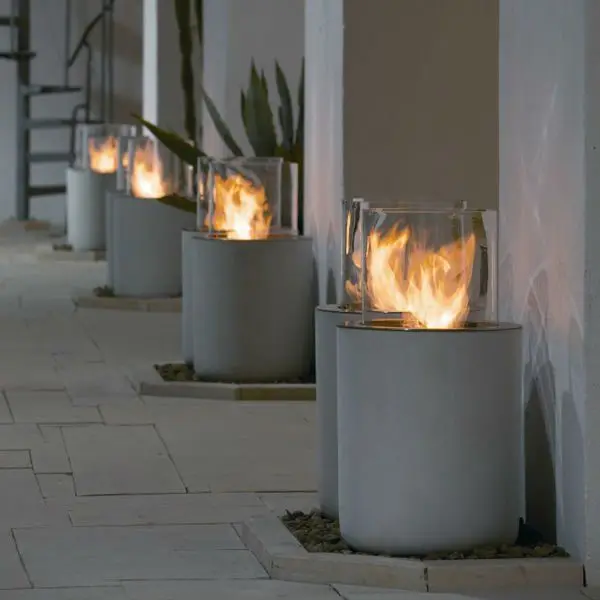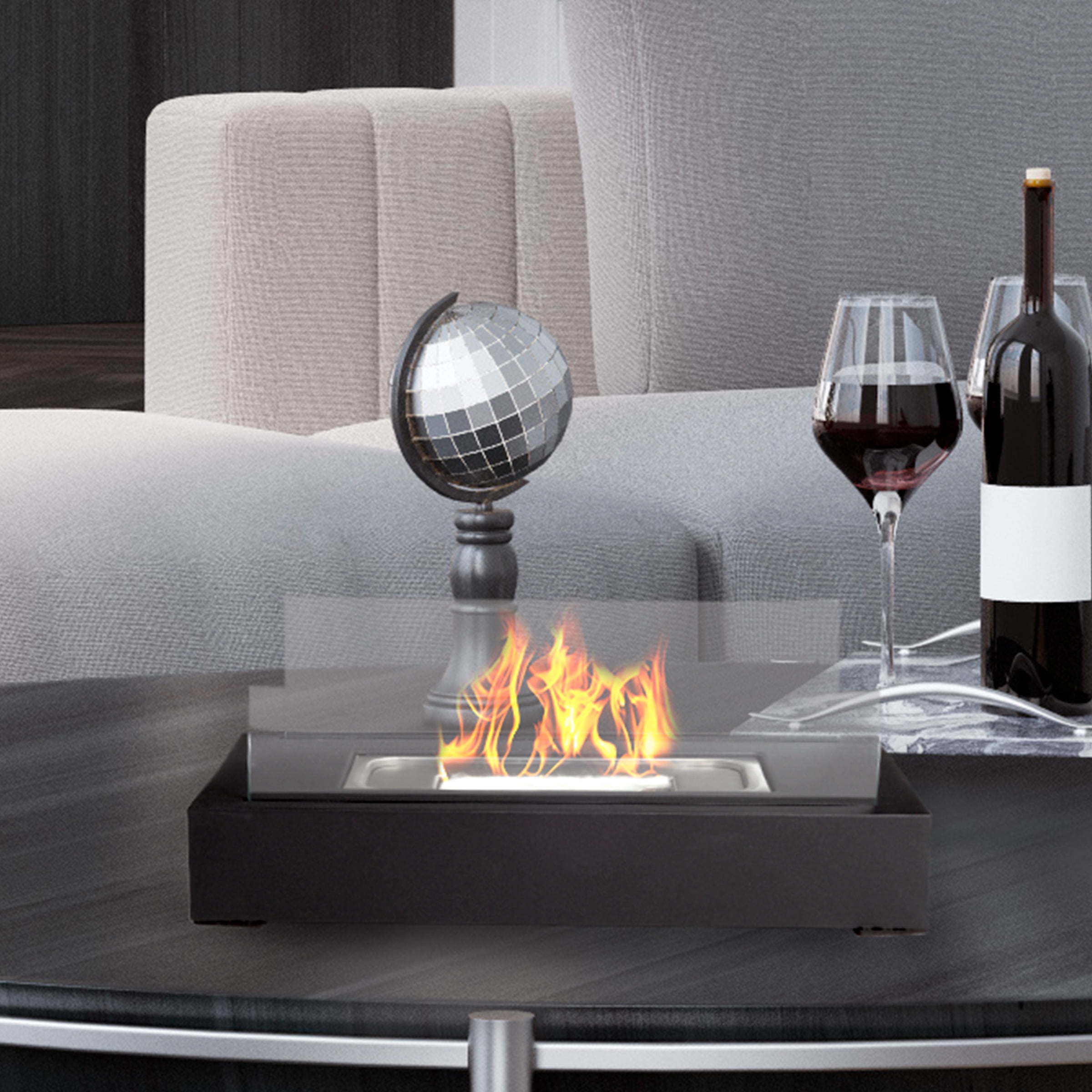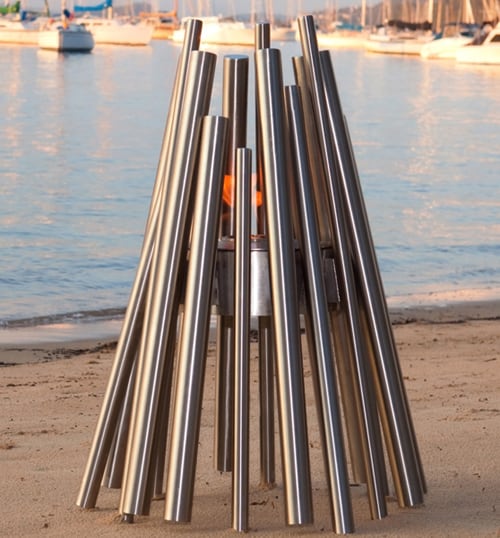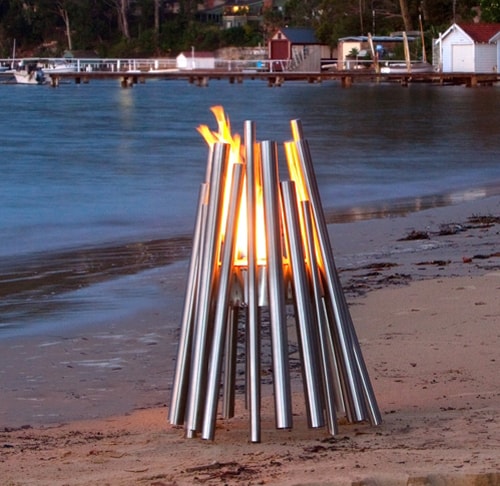Outdoor Fireplace Ethanol
An ethanol outdoor fireplace has become a popular choice for homeowners seeking warmth, ambiance, and a sleek, modern aesthetic for their outdoor spaces. Unlike traditional wood-burning or gas fireplaces, ethanol fireplaces run on bioethanol fuel, a renewable energy source derived from organic materials. These fireplaces offer a clean, smoke-free flame that can create a cozy atmosphere on patios, terraces, and backyards without the hassle of venting or extensive installation requirements. They combine style, functionality, and eco-friendliness, making them an attractive option for those who want to enjoy an outdoor fire experience with minimal environmental impact. Let’s discuss different aspects of ethanol outdoor fireplaces to understand their appeal and potential benefits.

Why Choose Ethanol Over Traditional Fuels?
The appeal of ethanol outdoor fireplaces largely stems from their simplicity and ease of use. Unlike wood-burning fireplaces, which require constant tending, cleaning of ashes, and the right fire-starting techniques, ethanol fireplaces operate on liquid bioethanol fuel that is poured directly into the fireplace’s fuel container. A match or lighter ignites the fuel, creating an immediate, clean-burning flame. This simplicity makes ethanol fireplaces ideal for those who want a quick, fuss-free way to enjoy a fire without the mess or upkeep associated with wood or gas.
In addition to being user-friendly, ethanol fireplaces are portable and versatile. Since they don’t require a chimney or permanent installation, they can be positioned almost anywhere, including on patios, balconies, or in garden areas. This flexibility gives homeowners the freedom to rearrange their outdoor spaces as desired, allowing for seasonal changes or for accommodating more guests. Ethanol fireplaces are available in a range of styles and sizes, from table-top models to freestanding structures, fitting seamlessly into different outdoor aesthetics and offering versatility that’s difficult to achieve with traditional fireplace options.
The environmental benefits of ethanol fuel also contribute to the growing popularity of ethanol outdoor fireplaces. Bioethanol is made from renewable resources like corn, sugarcane, and other plant materials, meaning it produces fewer pollutants when burned. Unlike gas or wood, which release toxins and contribute to air pollution, bioethanol combustion results in carbon dioxide and water vapor, minimizing its environmental impact. This feature appeals to eco-conscious homeowners looking for sustainable alternatives for their outdoor spaces.

What Makes it Eco-Friendly and Efficient?
Bioethanol fuel is derived from plant-based materials, making it a renewable resource and a greener alternative to fossil fuels. During the production of bioethanol, natural sugars in the raw materials are fermented, producing ethanol, which can then be purified and used as fuel. Unlike fossil fuels, which release carbon that has been stored in the earth for millions of years, bioethanol is considered carbon-neutral. This means that the carbon dioxide released during its combustion is offset by the amount absorbed by the plants during their growth. For eco-conscious users, this aspect makes ethanol outdoor fireplaces an attractive option for sustainable outdoor heating.
Another advantage of bioethanol fuel is its high efficiency. Ethanol fireplaces are designed to burn bioethanol at high temperatures, providing significant warmth despite their smaller size compared to wood or gas fireplaces. Ethanol burns with a clear, vibrant flame that not only adds aesthetic appeal but also generates heat efficiently, warming up outdoor spaces without requiring an excessive amount of fuel. While the heat output may not be as intense as a traditional wood-burning fireplace, ethanol fireplaces offer a comfortable level of warmth suitable for most outdoor settings, especially when used in covered or partially enclosed areas.
One notable characteristic of bioethanol is its clean-burning nature. Bioethanol produces minimal emissions, consisting mainly of carbon dioxide and water vapor, meaning there’s no smoke, ash, or soot to clean up. This makes ethanol fireplaces highly convenient, as they require minimal maintenance compared to traditional fireplaces. The lack of by-products also contributes to a healthier atmosphere, as there is no risk of inhaling toxic fumes or dealing with lingering smoke odors, making bioethanol fuel a particularly good option for gatherings where guests will be near the fire.

Types of Ethanol Outdoor Fireplaces
Ethanol outdoor fireplaces come in a range of designs, allowing homeowners to select one that best fits their space and aesthetic. Wall-mounted ethanol fireplaces, for instance, are an elegant option for patios and terraces, providing a modern, art-like appeal that enhances the outdoor décor. These units are often rectangular and feature glass enclosures to showcase the flame while protecting it from wind. They’re great for smaller spaces or for those who want a sophisticated look without taking up floor space.
For those who prefer a central focal point, freestanding ethanol fireplaces offer both style and function. These models are typically larger and designed to stand independently, making them ideal for larger outdoor areas where guests can gather around the fire. Freestanding units may come in a variety of shapes, from square to cylindrical, and many have built-in storage for extra fuel or decorative logs. These fireplaces provide the traditional fire experience while maintaining a sleek, modern design that complements various outdoor furniture and décor themes.
Tabletop ethanol fireplaces are a compact, versatile option for homeowners looking to add ambiance without committing to a larger fixture. These models can be placed on tables or ledges, making them perfect for small patios or balconies where space is limited. Many tabletop designs include a glass barrier that protects the flame from the wind while allowing full visibility, creating an intimate, candle-like atmosphere. Because of their portability, tabletop ethanol fireplaces can be moved indoors when not in use, adding flexibility for year-round enjoyment.
:max_bytes(150000):strip_icc()/bioethanol-fireplaces-self-supporting-central-open-hearth-63761-2889433-56a8869d3df78cf7729e8dc3.jpg)
Safety Considerations and Best Practices
While ethanol outdoor fireplaces are generally safe when used correctly, it’s essential to follow certain guidelines to ensure a safe experience. First, bioethanol is a highly flammable liquid, so it’s important to handle the fuel carefully, storing it in a cool, dry place away from direct sunlight and any open flames. When filling the fuel container, always do so cautiously, making sure the fireplace is cool to the touch to avoid accidental ignition of leftover fuel vapors. Ensuring these precautions can minimize the risks associated with handling bioethanol.
Operating an ethanol fireplace outdoors can also introduce specific challenges, such as wind affecting the flame. To counter this, it’s advisable to place the fireplace in a sheltered location, such as under a pergola or in a corner of the patio where the flame will be shielded from direct gusts. Many outdoor ethanol fireplace models include wind-resistant features like glass barriers or screens, which help maintain a steady flame even on breezy days. Regularly inspecting and cleaning these barriers will also improve visibility and safety, ensuring an uninterrupted, enjoyable experience.
One final aspect of safety to consider is fire extinguisher placement. Though rare, accidents can happen, and having a fire extinguisher nearby provides peace of mind. Ethanol fires can be extinguished with a fire blanket or by smothering the flame rather than dousing it with water, as water can spread the bioethanol fuel. By keeping safety measures in place, users can enjoy their ethanol fireplace with confidence, knowing they have taken the necessary steps to prevent accidents and ensure a pleasant experience.

Maintenance and Care Tips
One of the key advantages of ethanol fireplaces is their low-maintenance design. Unlike wood fireplaces that accumulate ash and require regular cleaning, ethanol fireplaces produce no soot, ash, or residue. However, it’s essential to keep the burner clean and free from dust and debris, which can accumulate over time. Regularly wiping down the fireplace with a damp cloth and mild detergent will keep it looking pristine and ensure that it functions optimally.
Glass components, common in many ethanol fireplace designs, should be cleaned regularly to prevent streaks or smudges from obstructing the flame’s visibility. Using a glass cleaner or a vinegar-water solution can help remove any stains and keep the glass sparkling. It’s also a good idea to inspect the seals and components periodically to make sure there are no leaks or loose fittings. Proper care not only keeps the fireplace looking new but also extends its longevity and safety.
When storing an ethanol fireplace during the offseason, particularly for freestanding or tabletop models, it’s advisable to cover or store them in a dry, sheltered area to protect them from harsh weather conditions. Fuel should be stored separately in a cool, dry place to prevent leaks or deterioration. By following these maintenance practices, users can ensure that their ethanol outdoor fireplace remains a durable, functional, and visually appealing feature in their outdoor space.

Cost and Value
Investing in an ethanol outdoor fireplace can range from moderate to high, depending on the style, brand, and size chosen. While they may initially seem more costly than some traditional options, the long-term value of an ethanol fireplace becomes apparent when considering its minimal maintenance, fuel efficiency, and eco-friendly benefits. Since ethanol fireplaces don’t require a gas line or ventilation, they eliminate the need for installation costs associated with other fireplace types, which can make them a cost-effective solution in the long run.
The fuel cost for ethanol fireplaces is generally reasonable, especially when compared to wood, which needs to be purchased and stored in large quantities, or gas, which may incur ongoing utility costs. Additionally, because ethanol burns cleanly, there’s no need to purchase additional cleaning materials, chimney sweep services, or replacement parts due to soot damage. These low operational costs make ethanol fireplaces not only a budget-friendly option but also one that is easy to maintain over time.
Finally, the aesthetic value of an ethanol outdoor fireplace is undeniable. Many models are designed with sleek, contemporary lines and materials like stainless steel and glass that add sophistication to any outdoor space. The ambiance created by a real flame, combined with the eco-friendly appeal, enhances the property’s value by adding a unique and attractive feature. For those seeking both style and practicality, investing in an ethanol outdoor fireplace provides a well-rounded solution that is both functional and visually pleasing.

Bio Ethanol Outdoor Fireplace by Ecosmart Fire – Stix

luxury ethanol outdoor fireplace for garden – China luxury ethanol outdoor fireplace for garden

on sale 48” fireplace outdoor with biofuel ethanol burner-in Fireplaces from Home Improvement

Outdoor Ethanol Fireplaces

DecorPro Cell Bio Ethanol Indoor / Outdoor Fireburner Tabletop Fireplaces, Indoor Outdoor

Built any fireplace you want with our ethanol burners! Sleek Fireplace, Modern Outdoor Fireplace

EcoSmart Fire Installation: Junction Moama, Victoria – Australia Biofuel Fireplace, Ethanol

Related Posts:
- Outdoor Fireplace Under Roof
- Outdoor Fireplace Hoods
- Indoor Outdoor Fireplaces Gas
- Outdoor Fireplace Instructions
- Outdoor Fireplace Screen Doors
- Outdoor Fireplace Forms
- Outdoor Fireplace Damper
- Outdoor Fireplace Pergola
- Outdoor Fireplace Under Pergola
- Outdoor Living Fireplace
Outdoor fireplaces are becoming increasingly popular among homeowners looking to bring warmth and ambiance to their outdoor living spaces. One of the most versatile options for outdoor fireplaces is ethanol-fueled fireplaces. In this guide, we will explore the benefits, pros and cons, common mistakes to avoid, and frequently asked questions related to outdoor fireplace ethanol.
Benefits of Outdoor Fireplace Ethanol
Environmentally Friendly: Ethanol is a renewable fuel source that produces clean flames with minimal emissions. Unlike wood-burning fireplaces, ethanol fireplaces do not release harmful pollutants into the air, making them an environmentally friendly choice for outdoor heating.
Easy to Use: Ethanol fireplaces are incredibly easy to use, requiring no electricity or gas lines. Simply fill the burner with liquid ethanol fuel and ignite it with a long lighter or match. This makes them a convenient option for homeowners looking for a hassle-free outdoor heating solution.
Clean Burning: Ethanol fireplaces produce a clean, smokeless flame that does not leave behind ash or soot like traditional wood-burning fireplaces. This means less maintenance and cleanup for you, allowing you to spend more time enjoying your outdoor living space.
Versatile Design: Outdoor fireplace ethanol comes in a variety of styles, shapes, and sizes to suit any outdoor decor aesthetic. From sleek and modern tabletop designs to rustic freestanding models, there is an ethanol fireplace option to complement any outdoor space.
Pros and Cons of Outdoor Fireplace Ethanol
Pros:
– Clean burning fuel source
– Easy to use and maintain
– Environmentally friendly
– Versatile design options
Cons:
– May have limited heat output compared to other fuel sources
– Fuel can be more expensive than traditional wood-burning options
Common Mistakes to Avoid
1. Overfilling the Burner: It’s important not to overfill the burner with ethanol fuel as this can lead to dangerous flare-ups and flames.
2. Igniting the Fireplace Too Close to Flammable Materials: Make sure to keep your ethanol fireplace at a safe distance from any flammable materials such as curtains or furniture.
3. Not Properly Ventilating the Area: While ethanol fireplaces produce clean flames, it’s still important to ensure proper ventilation in your outdoor space to prevent the buildup of carbon monoxide.
4. Leaving the Fireplace Unattended: Always supervise your ethanol fireplace while it is burning to prevent accidents or mishaps.
Can I use my indoor ethanol fireplace outdoors?
No, indoor ethanol fireplaces are specifically designed for indoor use only due to safety regulations and ventilation requirements.
How long does a tank of ethanol fuel last in an outdoor fireplace?
The burn time of a tank of ethanol fuel will depend on the size of the burner and how high you have the flames set. On average, a 1-liter tank can last anywhere from 4-6 hours.
Are ethanol fireplaces safe for children and pets?
While ethanol fireplaces are generally safe when used correctly, it’s important to supervise children and pets around any open flame to prevent accidents.
Can I cook food over an outdoor ethanol fireplace?
It is not recommended to cook food directly over an ethanol fireplace as it can produce harmful fumes that can contaminate your food.
Do I need to clean my outdoor ethanol fireplace regularly?
Yes, it’s important to regularly clean your outdoor ethanol fireplace to remove any soot or debris that may accumulate over time. This will help maintain its performance and extend its lifespan.
Outdoor fireplace ethanol is a versatile and convenient option for homeowners looking to add warmth and ambiance to their outdoor living spaces. With its clean-burning fuel source, easy maintenance, and environmentally friendly nature, ethanol fireplaces are a popular choice among many. By following safety precautions and proper maintenance practices, you can enjoy your outdoor fireplace ethanol for years to come. If you have any further questions or concerns, it’s always best to consult with a professional for guidance. Remember to always prioritize safety when using any type of outdoor heating appliance.